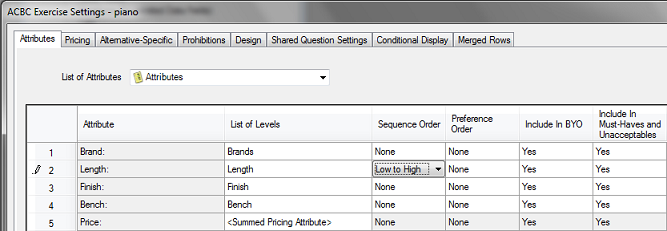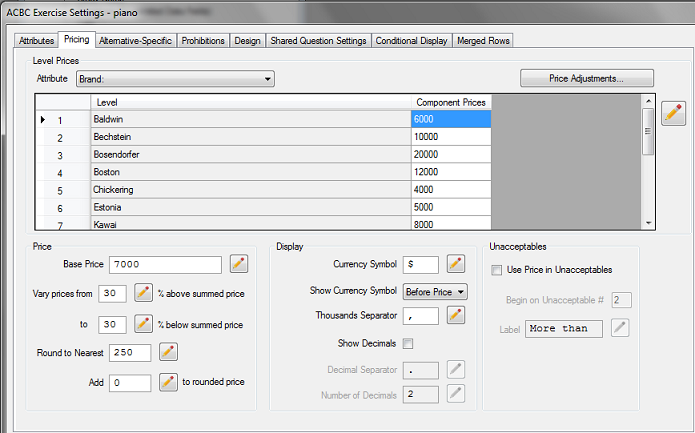Tutorial Specifications:
•Subject Matter: Grand pianos for home use
•Design Summary:
5 attributes
Summed Pricing, with additional price adjustments
Screening questions to develop list of considered brands (constructed list)
Note: This is an advanced ACBC tutorial. If you are beginning with ACBC, we suggest you first complete the "Beaches" Tutorial #1.
Setting: This project involves pricing research for grand piano purchases for home use, in the 6-foot (parlor grand) to 7.5-foot (small concert grand) range. There are very large price differences between brands, with the Steinway brand in particular charging a very high premium due to the hand-crafted nature of its pianos. We would like you to consider that you would be interviewing only sophisticated buyers in this niche market (who are both in the market and are highly knowledgeable about this product category).
Attribute List:
Attributes:
Brand:
Length:
Finish:
Bench:
Price:
Levels:
Brand:
Baldwin
Bechstein
Bosendorfer
Boston
Chickering
Estonia
Kawai
Kimball
Knabe
Petrof
Samick
Steinway
Wurlitzer
Yamaha
Young-Chang
Length:
6-foot
6.5-foot
7-foot
7.5-foot
Finish:
High-gloss black finish
Flat black finish
Wood grain finish
Bench:
Standard bench
Concert bench
Standard + concert bench
Price:
"Summed Price" per specifications below
Summed Pricing Grid Specifications:
Level: |
Level Prices: |
Additional Price Adjustments: |
Base Price |
$7,000 |
|
Baldwin |
$6,000 |
|
Bechstein |
$10,000 |
|
Bosendorfer |
$20,000 |
|
Boston |
$12,000 |
|
Chickering |
$4,000 |
|
Estonia |
$5,000 |
|
Kawai |
$8,000 |
|
Kimball |
$4,000 |
|
Knabe |
$2,000 |
|
Petrof |
$6,000 |
|
Samick |
$2,000 |
|
Steinway |
$30,000 |
|
Wurlitzer |
$4,000 |
|
Yamaha |
$8,000 |
|
Young-Chang |
$0 |
|
6-foot |
$0 |
|
6.5-foot |
$5,000 |
Steinway (+$15,000); Bosendorfer (+$10,000) |
7-foot |
$10,000 |
Steinway (+$25,000); Bosendorfer (+$18,000) |
7.5-foot |
$18,000 |
Steinway (+$40,000); Bosendorfer (+$25,000) |
High-gloss black finish |
$0 |
|
Flat black finish |
$0 |
|
Wood grain finish |
$0 |
|
Standard bench |
$0 |
|
Concert bench |
$0 |
|
Standard + concert bench |
$250 |
The table above provides the data to compute the total price for each grand piano (prior to varying its price by a random variation in the range -30% to +30%). For example, a 7-foot Yamaha with a standard bench would cost:
•Base Price ($7,000) + Yamaha ($8,000) + 7-foot ($10,000) + Standard bench ($0) = $25,000
But, Steinway and Bosendorfer are elite brands whose prices escalate (beyond the other brands) for the larger instruments in the 6.5 to 7.5-foot range. The additional premiums are given as Price Adjustments. For example, the price of a 7-foot Steinway with a standard bench is:
•Base Price ($7,000) + Steinway ($30,000) + 7-foot ($10,000) + Adjustment for Steinway @ 7-foot (+$25,000) + Standard bench ($0) = $72,000
Dynamic Brand List (Constructed Lists):
We recommend that not more than about seven levels of any attribute be brought into the ACBC exercise. Because this project involves 15 separate brands, we should drop some brands for each respondent and focus just on relevant brands. It is rare for an informed grand piano buyer to consider more than a handful of brands. Therefore, we will ask some preliminary screening questions to elicit the brands under consideration (and cap the maximum number of brands at seven).
ACBC estimates a full set of utilities for the respondent, even though most brands are excluded from each respondent's ACBC exercise. For each respondent, we inform utility estimation that the not-considered brands are inferior to the considered brands. Synthetic choice sets are added to the BYO portion of the design to indicate that the not-considered brands were rejected in favor of considered brands at their respective prices (if price premiums per brand are specified).
It is very important to consider that the data for the BYO section is coded as if respondents are making choices for each attribute separately traded off versus any price premiums for that same attribute (from the "Summed Pricing" grid). Therefore, if preliminary screening questions are used to establish which brands are chosen for inclusion in the ACBC exercise, these screening questions should refer to any price premiums (or discounts) that are associated with the levels.
For example, the screening question for brand could be represented as follows:
Q1. Please consider your upcoming purchase of a grand piano (6-foot to 7.5-foot). For your reference, the typical price for a 6-foot piano for different brands is as follows:
Typical Price for 6-foot Piano:
Baldwin |
$13,000 |
Bechstein |
$17,000 |
Bosendorfer |
$27,000 |
Boston |
$19,000 |
Chickering |
$11,000 |
Estonia |
$13,000 |
Kawai |
$15,000 |
Kimball |
$11,000 |
Knabe |
$9,000 |
Petrof |
$13,000 |
Samick |
$9,000 |
Steinway |
$37,000 |
Wurlitzer |
$11,000 |
Yamaha |
$15,000 |
Young-Chang |
$7,000 |
If these were your only options, which of the following brands would you consider? <show list of brands, multi-select format>
[ ] Baldwin
[ ] Bechstein
[ ] Bosendorfer
[ ] Boston
[ ] Chickering
[ ] Estonia
[ ] Kawai
[ ] Kimball
[ ] Knabe
[ ] Petrof
[ ] Samick
[ ] Steinway
[ ] Wurlitzer
[ ] Yamaha
[ ] Young-Chang
Programming the Project in Lighthouse Studio
As with the previous Beaches exercise (Tutorial #1), use the List Manager to establish pre-defined lists for the attributes and levels. (For the summed Price attribute, it should be included as a list element of the Attribute list.) The lists should be:
List: Attributes
Levels:
Brand:
Length:
Finish:
Bench:
Price:
List: Brands
Levels:
Baldwin
Bechstein
Bosendorfer
Boston
Chickering
Estonia
Kawai
Kimball
Knabe
Petrof
Samick
Steinway
Wurlitzer
Yamaha
Young-Chang
List: Length
Levels:
6-foot
6.5-foot
7-foot
7.5-foot
List: Finish
Levels:
High-gloss black finish
Flat black finish
Wood grain finish
List: Bench
Levels:
Standard bench
Concert bench
Standard + concert bench
Add an ACBC exercise to your study, and use the Attributes tab to specify your list of attributes and the level lists associated with each attribute. When you are finished, it should look like:

(Note that for now, we are specifying the "Brand" list, which contains all 15 brands. Soon, you'll write screener questions and build a constructed list that includes up to 7 considered brands for each respondent. You'll select that constructed list as the List of Levels for brand rather than the pre-defined Brand list that is currently shown above.
Next, specify your Summed Pricing Grid using the Pricing tab:

Using the drop-down control, select each attribute and cut-and-paste or directly type the price values into the Component Prices column. Note that we inserted the base price of $7,000 into the Base Price field. We have specified to vary summed prices by +/-30%, rounded to the nearest $250.
Next, you need to establish the Price Adjustments for Steinway and Bosendorfer. Click the Price Adjustments... button.

The grid above gives you great flexibility for inserting additional price adjustments. In our situation, the price adjustments are quite simple, because they are based on just two attributes (Attribute #1: Brand & Attribute #2: Length).
For example (row 1 above), we add $15,000 to the cost of Attribute 2, Level 2 (Length: 6.5-foot) if Attribute 1, Level 12 (Steinway) occurs.
The last major step to programming this exercise is to create a screener question (Q1) that asks respondents to provide a list of brands they consider. It could also be done in two steps: a question that asks for the one most likely brand, and then a follow-up question that asks for other considered brands. In either case, you develop a new constructed list of brands with no more than 7 brands on the list. On the Attributes tab, you'll select the constructed list of brands for Attribute 1 rather than the pre-defined brands list.
(We show an example using constructed lists for a Brand attribute in the section entitled Customized (Constructed) Attribute and Level Lists.)